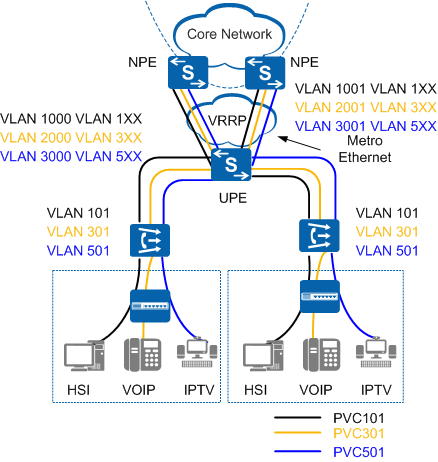Public User Services on a Metro Ethernet Network
In Figure 1, the digital subscriber line access multiplexers (DSLAMs) support multiple permanent virtual channels (PVCs). This allows each user to use multiple services such as High-Speed Internet (HSI), Internet Protocol Television (IPTV), and voice over IP (VoIP).
The carrier assigns different PVCs and VLAN ranges to HSI, IPTV, and VoIP services, as listed in Table 1.
Service |
VLAN Range |
|---|---|
HSI |
101 to 300 |
VoIP |
301 to 500 |
IPTV |
501 to 700 |
In VoIP communication, when a VoIP packet reaches a DSLAM through a specified PVC, the DSLAM marks the packet with a VLAN in the VLAN range mapped to the PVC (for example, 301). When the VoIP packet reaches the UPE, the UPE tags the packet with an outer VLAN ID mapping the VoIP VLAN ID range (for example, 2000). The inner VLAN ID represents user information, whereas the outer VLAN ID represents service information and the location of the DSLAM (packets from different DSLAMs are tagged with different outer VLAN IDs). When the packet reaches the NPE indicated by the outer VLAN tag, the VLAN tag is terminated on the QinQ termination sub-interface. The packet is then forwarded on the IP network or enters the corresponding VPN according to the core network configuration.
HSI and IPTV service packets are processed in the same manner, except that VLAN tags of HSI service packets are terminated on a broadband remote access server (BRAS).
The NPE can perform HQoS scheduling based on double tags and generate a DHCP binding table to avoid network attacks. In addition, the NPE can implement DHCP authentication based on double tags and other information. You can also configure VRRP on QinQ termination sub-interfaces to ensure service reliability.
